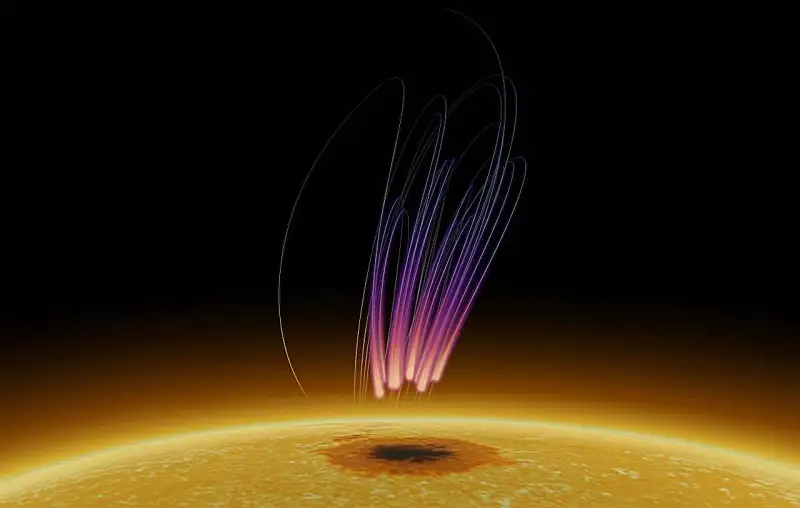In a study published in Nature Astronomy, astronomers at the New Jersey Institute of Technology’s Center for Solar and Terrestrial Research (NJIT-CSTR) discovered that an unusual aurora-like event occurred 40,000 km above a known relatively dark and cold spot. We conducted detailed radio observation of the exterior. Like the sun and sunspots.
The researchers believe that this new radio emission shares characteristics with auroral radio emission commonly observed in planetary magnetospheres, such as those around Earth, Jupiter, and Saturn, and in certain low-mass stars. It has said.
According to study lead author and NJIT-CSTR scientist Sijie Yu, the discovery provides new insight into the origin of these intense solar radio bursts and suggests that they may be found in distant stars with large star spots. The researchers say this could open up new avenues for understanding similar phenomena.
“We discovered a special type of long-lasting polarized radio burst that originates from sunspots and lasts for more than a week,” Yu said. “This is very different from typical ephemeral solar radio bursts that usually last minutes to hours. This is an exciting discovery that has the potential to change our understanding of magnetic processes in stars. ”
Famous aurora shows seen in the skies of the Earth’s polar regions, such as the Aurora Borealis and Aurora Australis, are caused by solar activity disrupting the Earth’s magnetosphere and the precipitation of charged particles in the Earth’s polar regions where magnetic fields converge and interact. Occurs when promoted. Oxygen and nitrogen atoms in the upper atmosphere. As these electrons accelerate toward the north and south poles, they can generate powerful radio emissions with frequencies on the order of a few hundred kHz.
Yu’s team found that the newly observed solar radio radiation is found in vast sunspot regions that temporarily form on the Sun’s surface in areas where the magnetic field is particularly strong, and that it is both spectrally and temporally distinct. It is said that this is different from previously known solar radio noise storms.
“Our spatially, temporally, and spatially resolved analyzes suggest that this is due to electron cyclotron maser (ECM) emission, where high-energy electrons are trapped in the shape of a converging magnetic field.” explained Yu.
“The cold, highly magnetic regions of sunspots provide a favorable environment for the generation of ECM radiation and are parallel to the magnetic polar caps of planets and other stars, making it possible to use local solar radiation to study these phenomena. We may provide similar products.”
“However, unlike Earth’s auroras, auroral radiation from sunspots occurs at frequencies ranging from hundreds of thousands of kHz to about 1 million kHz. This is due to the sunspot’s magnetic field, which is thousands of times stronger than Earth’s magnetic field.
We show that these radio bursts are not necessarily related to the timing of solar flares,” says the Swiss University of Applied Sciences North West (FHNW). added Rohit Sharma, a scientist at ) and co-author of the study. “Instead, it appears that sporadic flare activity in nearby active regions sends energetic electrons into large magnetic field loops anchored by sunspots, causing ECM radio emissions throughout the region. .”
Sunspot radio auroras are thought to exhibit rotational modulations synchronized with the sun’s rotation, resulting in what Yu calls the “cosmic lighthouse effect.”
“When a sunspot crosses the solar disk, it produces a rotating beam of radio light, similar to the modulated radio auroras observed from rotating stars,” Yu noted. “This sunspot radio aurora is the first discovery of its kind, so our next steps will include retrospective analysis. Our goal is to find out if some of the previously recorded solar flares , to find out whether this newly identified radiation is an example of a star resembling a sunspot. It can be the source of certain radio bursts observed in a variety of stellar environments.
This observation is one of the clearest pieces of evidence of radio ECM radiation we have seen from the Sun. Bin Chen, associate professor of physics at NJIT-CSTR and co-author, said: “This property is similar to what is observed on our planet and other distant stars, and this model supports other stars with sunspots. “We think this may be applicable to stars as well.” . author.
Research team says recent discoveries linking the Sun’s behavior to the magnetic activity of other stars could influence astrophysicists to reconsider current models of stellar magnetic activity. There is.
Surajit, a solar researcher at NJIT, said, “We have a lot of questions about how high-energy particles and magnetic fields in our system interact with not only our Sun, but also the presence of long-lived sunspots on stars far outside our solar system.” We are beginning to solve the mystery.” Mondal.
“By understanding these signals from our Sun, we can better interpret the powerful radiation from M dwarfs, the most common type of star in the universe, and learn more about fundamental astrophysical phenomena. We may be able to uncover a connection,” added NJIT-CSTR Distinguished Dale Gary. Professor of Physics.
The research team, including co-investigators Marina Battaglia of FHNW and Tim Bastian of the National Radio Astronomy Observatory, made the discovery using broadband dynamic radio imaging spectroscopy observations from the Karl G. Jansky Very Large Array. I did it.
